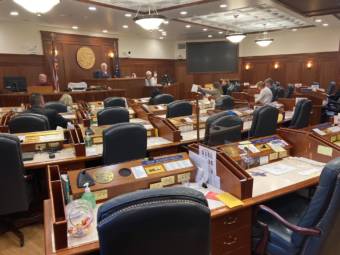
An Anchorage judge will decide in the next two weeks whether more than $400 million will remain in a state fund that pays for scholarships and need-based grants for Alaskans to attend college.
Lawyers for four Alaska university students and the state government presented their arguments to Superior Court Judge Adolf Zeman on Tuesday to determine the future of the Alaska Higher Education Investment Fund. The fund was started in 2012 with $400 million.
But three years ago, Gov. Mike Dunleavy’s administration started sweeping the money into the Constitutional Budget Reserve, a state savings account, unless three-quarters of both the Senate and House of Representatives agreed to keep it in the higher education fund. That failed to happen last year.
So, in January, four students sued to maintain the fund.
Jahna Lindemuth, the students’ lawyer, argued that the state misapplied a provision of the constitution that determines what money will be swept into the Constitutional Budget Reserve each year. She served as the attorney general in the administration of former Gov. Bill Walker, an independent who is challenging Dunleavy, a Republican, in this year’s election.
Lindemuth said Dunleavy had proposed language in a bill that would have eliminated the fund, which the Legislature failed to pass. She said that it wasn’t until after that happened that the administration reached its conclusion that the higher education fund money was subject to being swept without legislation.
“The governor simply has different legislative priorities than the Legislature,” she said, adding that it was a “money grab that fundamentally violates the Legislature’s rights” under the constitution.
Assistant Attorney General Margaret Paton-Walsh represents the state in the case. She noted that the state constitution requires that unspent money in the general fund that’s available to be spent in the annual budget — also known as being “appropriated” — be swept in into the Constitutional Budget Reserve. She said that applies to the money in the Alaska Higher Education Investment Fund, which the law defines as being in the general fund.
“The Legislature is quite free to appropriate that money for any purpose that it wants,” she said. “There is no dispute about that fact.”
The judge noted that students rely on scholarships for several years, and asked Paton-Walsh if that makes the higher education fund similar to the state setting aside money for a construction project that lasts several years.
“How’s that different than a four-year education?” he asked.
She replied that with the higher education fund, the Legislature has to take two separate actions: putting money into the fund and then spending it on programs like scholarships.
But with a multi-year construction project, it only appropriates it once. And the Legislature doesn’t appropriate it again for the same construction project in multiple years.
“That money is not available for appropriation because the executive branch can spend it without any further action by the Legislature, ” she said of a multi-year construction project.
The state now considers the $422.8 million that was in the higher education fund to be part of the Constitutional Budget Reserve, which has another roughly $1 billion.
Dunleavy has proposed funding the Alaska Performance Scholarships, need-based Alaska Education Grants and the state’s medical education program in the budget for the coming fiscal year.
The money for those programs wouldn’t come from the higher education fund, but instead from the general fund, which pays for the rest of the state budget. Without the money in the Alaska Higher Education Investment, the students expressed concern that there wouldn’t be funding for the programs in future budgets.
Judge Zeman said he would issue a decision by Feb. 22. That could allow time for the case to be appealed to the state Supreme Court and resolved by the time the Legislature finishes its work on the budget.



